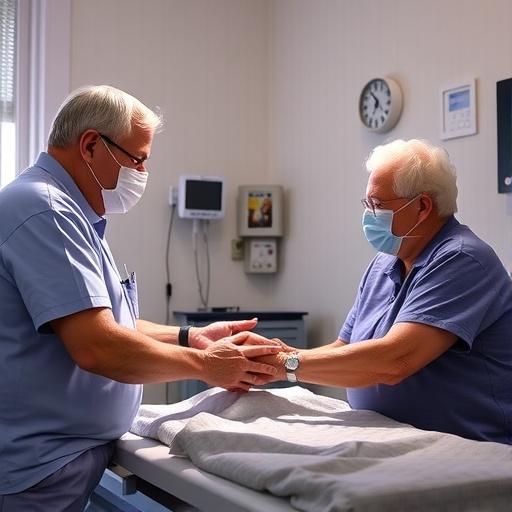In the context of a global pandemic, the response of healthcare systems has been scrutinized, with particular attention on the implications for vulnerable populations. A recent qualitative study conducted by Ryan et al. delves into the experiences of community-dwelling older adults regarding their decisions to visit the Emergency Department (ED) during the COVID-19 crisis. This piece seeks to shine a light on an often-overlooked segment of the population that faced unique challenges during these unprecedented times.
As the pandemic unfolded, public health guidelines and the uncertainty surrounding the virus led to a dramatic shift in healthcare-seeking behavior among various demographics, notably older adults. The study reveals that this demographic not only faced heightened health risks but also acute psychological barriers that complicated their interactions with healthcare systems. The qualitative insights provided by this research elucidate the multifaceted considerations these individuals grappled with while assessing their healthcare needs amidst the pervasive fear of COVID-19.
Participants in the study recalled their pre-COVID interactions with healthcare services as markedly different from their experiences during the pandemic. Many older adults expressed apprehension about visiting hospitals, fearing exposure to the virus, which could lead to severe health complications. This fear, compounded by the constant stream of public health messaging emphasizing social distancing, created an environment of trepidation that influenced their decision-making processes regarding seeking care.
Interviews conducted with study participants revealed that numerous older adults perceived the ED as a site of potential contagion. This perception led to the delayed treatment of critical health issues, as individuals chose to prioritize their safety over their healthcare needs. The emotional burden associated with this choice was substantial, often resulting in increased levels of anxiety and a feeling of isolation as they navigated their health concerns without immediate, direct medical intervention.
Moreover, the study highlighted the role of telehealth as a potential substitute for in-person visits. Some participants noted that virtual consultations provided a new avenue to discuss their health issues without the associated risks of an ED visit. However, the effectiveness of telehealth varied greatly among individuals, particularly those who were less technologically savvy or lacking access to proper devices. While telehealth emerged as a valuable resource, it also underscored the digital divide that exists, further marginalizing those who were already vulnerable.
Another significant finding from the study was the crucial impact of social support networks on decision-making. Older adults who had strong family or community ties were more likely to discuss their healthcare concerns with trusted individuals, leading them to seek care sooner than those who felt isolated. The research emphasizes the importance of community engagement and ongoing support, especially for older adults during crises. Social interactions served as a vital mechanism for mitigating fear and encouraging timely medical attention.
Furthermore, the study explored the longitudinal effects of these experiences on participants. Health outcomes for older adults who delayed seeking emergency treatment due to fear of COVID-19 are still being understood. There is a potential for neglecting underlying conditions that could exacerbate in the long term without appropriate medical care.
As the healthcare landscape evolves post-pandemic, Ryan et al.’s study makes a vital contribution to understanding the experiences of older adults within emergency healthcare frameworks during extraordinary circumstances. Their findings urge stakeholders within public health and emergency medicine to rethink the systems in place for elderly patients. Protocols must adapt not only to accommodate their needs but also to alleviate the psychological barriers that deter them from seeking necessary care.
The implications of this research extend beyond immediate healthcare interactions; it also calls for a reassessment of the infrastructure supporting older adult care within the community. Healthcare systems must ensure that older adults feel safe and supported in their medical journeys, regardless of external circumstances such as a pandemic. Allowing for a more responsive and empathetic healthcare model could significantly enhance healthcare-seeking behaviors in future health crises.
In conclusion, the qualitative insights from Ryan et al. highlight critical lessons from the COVID-19 pandemic regarding healthcare engagement by older adults. Their research underscores the importance of community support, effective communication about health risks, and the necessity to provide safe pathways for healthcare access. As we move forward, integrating these findings into practice could pave the way for a more resilient healthcare system that equips older adults with the confidence and mechanisms to seek timely care when they need it most.
Subject of Research: The decision-making processes and experiences of community-dwelling older adults regarding Emergency Department visits during COVID-19.
Article Title: Community dwelling older adults’ decision to, and experience of attending the Emergency Department during COVID-19: a qualitative study.
Article References:
Ryan, S., Barry, L., Fitzgerald, C. et al. Community dwelling older adults’ decision to, and experience of attending the Emergency Department during COVID-19: a qualitative study.
BMC Geriatr 25, 714 (2025). https://doi.org/10.1186/s12877-025-06401-x
Image Credits: AI Generated
DOI:
Keywords: COVID-19, older adults, Emergency Department, healthcare access, telehealth, qualitative study, community support.




